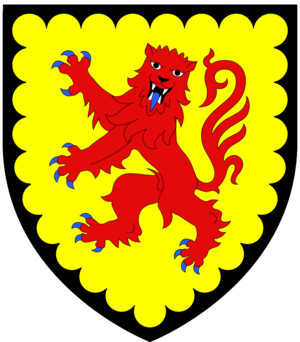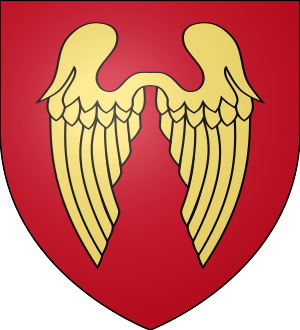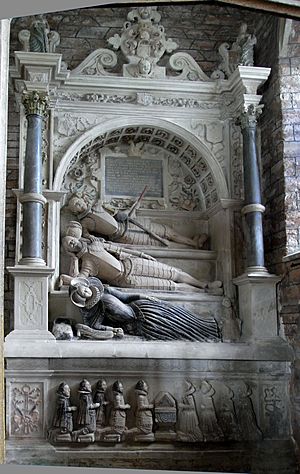Feudal barony of Berry Pomeroy facts for kids
The Feudal Barony of Berry Pomeroy was an important area of land in Devon, England, during the Middle Ages. It was one of eight such baronies in Devon. The main center, or caput, of this barony was at the manor of Berry Pomeroy. This place is about 20 miles south of the city of Exeter and 2 miles east of Totnes. The exact spot where the first baron lived in the 11th century isn't clear. It might have been near the church, where Berry House now stands. The famous ruined Berry Pomeroy Castle nearby was probably built much later, in the 15th century.
The Pomeroy family owned this manor and barony for a very long time, from before 1086 until 1547. Then, Edward Seymour, 1st Duke of Somerset, bought it. It has stayed in his family ever since. Today, the manor and much of the old estate belong to his descendant, the Duke of Somerset, who lives at Maiden Bradley House in Wiltshire.
Contents
- The Pomeroy Family: Early Owners
- The Seymour Family: New Owners
- Edward Seymour, 1st Duke of Somerset (c.1500–1552)
- Lord Edward Seymour (1529–1593)
- Sir Edward Seymour, 1st Baronet (c.1563–1613)
- Sir Edward Seymour, 2nd Baronet (c.1580–1659)
- Sir Edward Seymour, 3rd Baronet (1610–1688)
- Sir Edward Seymour, 4th Baronet (1633–1708)
- Sir Edward Seymour, 5th Baronet (1663–1741)
- Edward Seymour, 8th Duke of Somerset (1694–1757)
- Sources
The Pomeroy Family: Early Owners
The Pomeroy family were the first owners of the Berry Pomeroy barony. They held it for centuries.
Ralph de la Pomeroy (died before 1100)
Ralph was the first feudal baron of Berry. A "feudal baron" was a powerful landowner who held his land directly from the king in exchange for military service. In 1086, he was one of the main landowners in Devon listed in the Domesday Book. He also owned land in Normandy, France. Ralph helped collect taxes in Devon for the king.
William de la Pomeroy (died before 1114)
William was Ralph's oldest son. He gave the manor of Berry to a church, but his brother Joscelin later got it back.
Joscelin de la Pomeroy (died after 1123)
Joscelin was William's younger brother. He helped rebuild a church in Normandy. He also gave churches in Devon, including Berry, to this church.
Henry de la Pomeroy (died before 1165)
Henry was Joscelin's son. He was a knight who served King Henry I. He was even a "Constable of Normandy," which meant he was a leader of the king's soldiers. He fought in battles for the king.
Later Pomeroy Barons
Many generations of Henry's family continued to own Berry Pomeroy. They were important figures in Devon and sometimes in the wider kingdom.
- Henry de la Pomeroy (died 1201/7): He was the eldest son of the earlier Henry. His wife, Rohesia, later married Sir John Russell.
- Henry de la Pomeroy (died 1222): He married Joan de Vautort, whose family were also feudal barons of nearby Totnes.
- Sir Henry de la Pomeroy (1266–1305): He was born in Cornwall. He married Amice de Camville.
- Sir Henry de la Pomeroy (1291–1327): He married Joan de Moels.
- Sir Henry de la Pomeroy (died 1373): Another Henry in the line.
- Sir John de la Pomeroy (1347–1416): He had no children. After his death, there was a dispute over who would inherit the barony.
- Sir Thomas Pomeroy (died 1426): He briefly held the lands after Sir John, but his claim was complicated. The lands eventually went back to Sir John's chosen heir.
- Edward de Pomeroy (died 1446): He was the rightful heir after Sir Thomas. He married Margaret Beville.
- Henry de Pomeroy (1416–1481): He was Edward's son. His oldest son died before him.
- Sir Richard de Pomeroy (1442–1496): He was a "Sheriff of Devon" (a high-ranking official in the county) and was knighted by King Henry VII. His tomb is still in Berry Pomeroy Church.
- Sir Edward de Pomeroy (1478–1538): He married Johanna Sapcot.
- Sir Thomas Pomeroy (1503–1566): He was the last Pomeroy to own Berry Pomeroy. In 1547, he sold the castle, park, and manor to Edward Seymour, 1st Duke of Somerset.
The Seymour Family: New Owners
After the Pomeroy family, the powerful Seymour family took over Berry Pomeroy.
Edward Seymour, 1st Duke of Somerset (c.1500–1552)
He was a very important person in England during the time of King Edward VI. He bought Berry Pomeroy in 1547 and gave it to his oldest son from his first marriage.
Lord Edward Seymour (1529–1593)
He was the son of the 1st Duke of Somerset. He also served as a "Sheriff of Devon."
Sir Edward Seymour, 1st Baronet (c.1563–1613)
He was Lord Edward's son. He was a "Member of Parliament" (MP), meaning he was elected to represent Devon in the country's government. He spent a lot of money making Berry Pomeroy Castle bigger, adding new parts around 1600. His monument in Berry Pomeroy Church shows statues of him, his father, and his family.
Sir Edward Seymour, 2nd Baronet (c.1580–1659)
He was the son of the 1st Baronet. He was also an MP. During the English Civil War, he supported the King (Royalist) and was captured.
Sir Edward Seymour, 3rd Baronet (1610–1688)
He was the son of the 2nd Baronet and also an MP for Devon. In 1688, he hosted William of Orange at Berry Pomeroy. William later became King of England.
Sir Edward Seymour, 4th Baronet (1633–1708)
He was the son of the 3rd Baronet. He became the "Speaker of the House of Commons," a very important role in Parliament. He decided to move his main home to Bradley House in Wiltshire, and Berry Pomeroy Castle was left empty.
Sir Edward Seymour, 5th Baronet (1663–1741)
He was the son of the 4th Baronet and also an MP.
Edward Seymour, 8th Duke of Somerset (1694–1757)
He inherited the title of Duke of Somerset from a distant cousin. After him, the ownership of Berry Pomeroy continued to pass down through the Dukes of Somerset family.
Sources
- Pomeroy, Albert A., History and Genealogy of the Pomeroy Family, 3 parts, Detroit, USA, 1922, part 3 [1]
- Powley, E.B. The House of De La Pomerai, Liverpool, 1944
- Prince, Rev. John, Worthies of Devon (1701), 1810 edition, pp. 645–9, Pomerai, Sir Henry, Lord of Biry
- Sanders, I.J. English Baronies, Oxford, 1960, pp. 106–7, Berry Pomeroy
- Vivian, Lt.Col. J.L., (Ed.) The Visitations of the County of Devon: Comprising the Heralds' Visitations of 1531, 1564 & 1620, Exeter, 1895, pp. 605–9, Pomeroy




